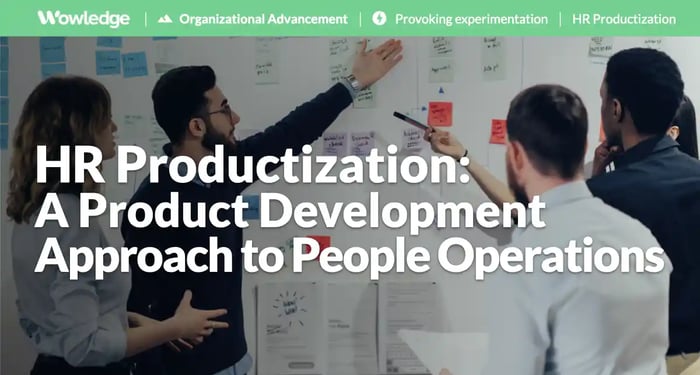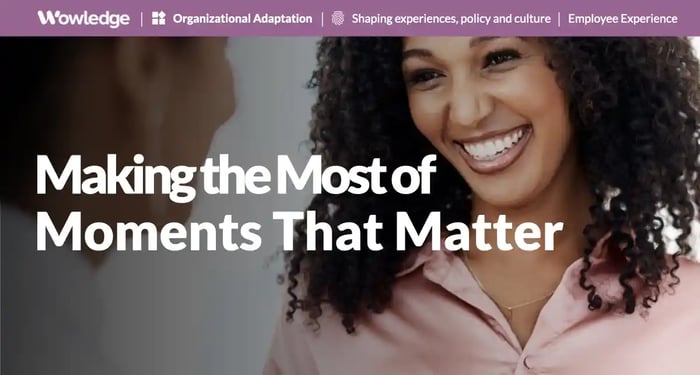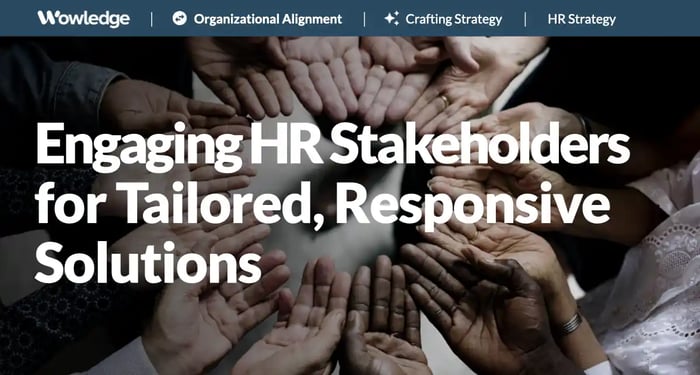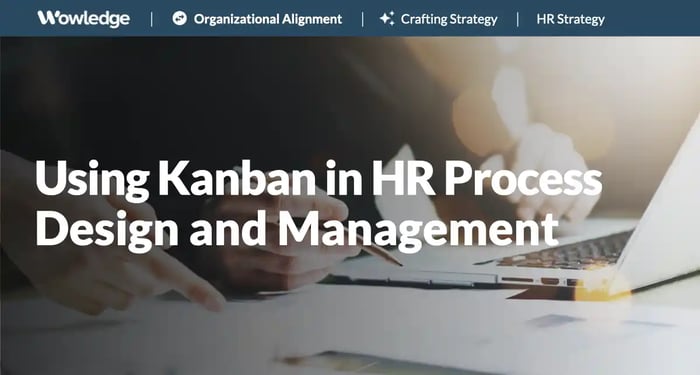Table of Contents
Given the concurrent issues of labor shortages, low engagement levels, high burnout, increased employee leverage, and changing generational demands facing organizations, HR professionals are challenged to deliver more value faster and with more significant impact. They are expected to do more with less and stay up with—and even anticipate—changing trends and considerable market disruptions. This is impossible using the old command and control, rigid plan-and-execute models designed for a slower-changing, more predictable era when talent was “a human resource” expected to remain compliant with management orders. “HR productization” offers a new perspective and process to resolve this, as these VUCA (Volatility, Uncertainty, Complexity, Ambiguity) times require planned and constant innovation.
Is HR an innovative discipline?
Let’s face it: HR does not have the reputation of being the most innovative discipline. But it does innovate—a lot. However, it is often unplanned, reactive, and inefficient, unintentionally and unwillingly continuously innovating in response to volatile, uncertain, complex, and ambiguous environmental stimuli.
HR practitioners are “chaos wranglers,” constantly and pointlessly trying to retrofit reality to the original plans. Therefore, most innovation efforts are spent in futile cat-herding endeavors. Who has an appetite for intentional change after that?
The changes in the last decades around the relationship between employees and employers, between people and their jobs, and fierce competition for highly sought-after profiles have made it even more evident that the working relationship is not a given but a choice. HR productization offers an approach to improving that relationship significantly.
And it’s a choice that is mutually renewed payroll after payroll. You attract, convert, and onboard employees. You develop and engage employees, measure the value they create, and gradually increase the value of the relationship to retain them rather than lose them to the competition. But even then, the reality is that organizations have to deal with churn.
It is like a subscription service. Wait! That sounds EXACTLY like a subscription service. If HR behaves like a product, you need to productize it.
People Operations (a movement born from the unique challenges of product-savvy technology startups that needed to scale their teams and practices at blistering speed) and HR Productization are revolutionary approaches that apply product management principles to human resources practices. This guide will explore how treating HR initiatives as products can transform organizational practices, leading to better alignment with business goals, improved employee experiences, and more efficient HR processes.
Understanding HR productization
HR productization is an approach borrowed from product design and marketing that treats all HR processes, programs, policies, and practices as products or services to be designed and refined in such a way as to make their customers (managers or employees) thrilled to use them. It involves reimagining HR practices as user-centric, scalable products that solve specific problems for employees and the organization. The aggregated suite of products creates the employee experience (EX). And that makes you, as the HR leader in your organization, the Product Manager of this Employee Experience, in charge of evolving it to be the best it can be, as experienced by your users/stakeholders.
This approach shifts HR from a reactive, process-driven function to a proactive, value-driven one. By adopting a product mindset, HR professionals can create solutions that are more responsive to user needs, easier to scale as the organization grows, and capable of delivering measurable impact.
Nine key principles of HR productization
1. Align HR with the business
HR productization begins with aligning HR initiatives to organizational goals. By defining HR-focused OKRs (Objectives and Key Results) and KPIs (Key Performance Indicators) that align with and contribute to higher-level goals, HR can tangibly demonstrate its direct contribution to business success. This alignment ensures that HR products push the entire organization forward rather than existing in isolation or—even worse—holding it back. Clearly articulating the measurable progress contribution of HR to organizational goals is key to earning HR’s proverbial seat at the table.
Sample
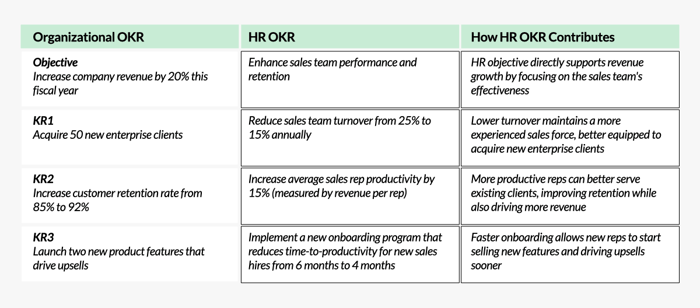
Where to start:
- Conduct a workshop with business leaders to understand key organizational goals
- Develop HR OKRs that directly support these business objectives
- Create a dashboard to track and report HR's impact on business KPIs
- Schedule regular check-ins with department heads to ensure ongoing alignment
2. Delight your employees
The commitment to engaging employee experiences is at the heart of HR productization. This principle emphasizes the importance of user-centric design in HR products, focusing on solving fundamental pain points and meeting the genuine needs of your workforce. The process starts with mapping your employees’ journey through its ups and downs to understand positive and negative experiences and assess their impact on the overall journey. This exercise generates more actionable insight that can be prioritized for execution.
As with clients, the goal here is to understand your users and their needs and wants, eliminate all sources of unnecessary friction, and find ways to delight them to ensure their renewed engagement and commitment.
HR productization methodologies like Design Thinking, with its many different tools to Empathize, Define, Ideate, Prototype, Test, and Implement your ideas, frameworks, and "jobs-to-be-done" to understand user goals and expectations, or the Kano Model to prioritize initiatives by comparing the "delight" they promise vs. the "investment" they require, can guide your exploration through qualitative and quantitative evidence without forcing you to rely purely on intuition.
Sample
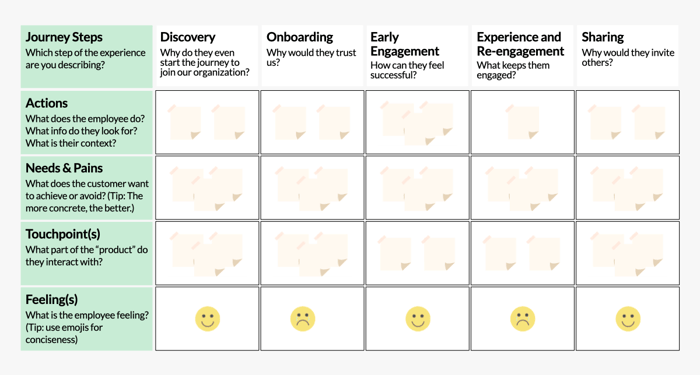
Where to start
- Conduct employee surveys and user interviews to identify pain points in current HR processes
- Create user personas for different employee groups in your organization
- Design and test a prototype of a new HR service with a small group of employees
- Implement a continuous feedback loop for HR initiatives
3. Deliver faster, deliver often
Adopting agile HR practices allows for quicker delivery and more frequent iterations. This principle encourages HR teams to optimize their velocity and collaboration, resulting in faster initiative implementation and more opportunities for feedback and improvement.
At the core of all obstacles to collaboration lie the communication issues that teams commonly face in their pursuit of complex deliverables. This challenge is not unique to HR: other disciplines like manufacturing and software development learned decades ago that establishing agile, iterative delivery processes can significantly help when setting dynamic and flexible goals under unpredictable conditions.
Some HR productization tools and frameworks like Kanban can be easily adapted to HR projects due to their flexibility built on top of solid foundational principles like:
- Visualizing your work (using dashboards to show commitments and progress)
- Limiting work in progress (reducing the opportunities for unproductive overcommitment)
- Managing flow (visualizing your backlog of work and any bottlenecks in resource allocation)
- Making policies explicit (bringing clarity and transparency to internal commitments and service expectations)
Defining shorter work cycles (e.g., two-week “sprints”) for the HR product (or process, program, policy) design helps establish a predictable cadence of value delivery. Utilizing agile ceremonies like standup and retrospective meetings ensures alignment and reflection for continuous improvement in your team.
Where to start
- Introduce agile methodologies to your HR team through a training workshop
- Start with a small HR project and run it using agile principles (sprints, standups, etc.)
- Implement a Kanban board for visualizing HR work and identifying bottlenecks by limiting the work in progress, managing the flow, making process policies explicit, and improving collaboratively.
- Establish regular retrospectives to improve your HR delivery process continuously
4. Make important decisions more confidently
Data-driven insights are crucial for strategic HR decision-making. This principle emphasizes the importance of collecting and analyzing relevant HR data to inform product development and strategic choices, leading to more confident and effective decision-making.
Every transaction within the spectrum of HR practices generates a record (an interview, a hiring decision, a training completion, a compensation review, a promotion, etc.) that can be leveraged, in aggregation, to uncover trends and patterns that allow you to anticipate and even predict future challenges, enabling proactive, rather than reactive, HR strategies.
Where to start
- Audit your current HR data sources and identify gaps: What data do you have from your HR systems? What data are you missing? Is it messy or incomplete?
- Implement an HR analytics tool to centralize and visualize your people data. Tip: Consult with other parts of the organization to see if there is already a tool and internal expertise that you can leverage.
- Train HR team members on fundamental data analysis and interpretation
- Start producing monthly data-driven HR insights reports and dashboards for leadership
5. Grow your practice and your organization
Achieving scalable efficiency through modular People Operations is crucial to efficiency and growth. This principle focuses on designing HR solutions that can quickly scale with the organization, ensuring that HR practices remain effective and consistent as the company expands. Learning from companies that have developed proven approaches to People Operations is always a good idea.
Most of the People Operations approach was developed by startups in the technology and Software-as-a-Service (SaaS) space to pursue faster, more efficient practices to support their exponential growth. Leveraging their expertise with frameworks, playbooks, and process optimization/automation, they build supercharged systems that replicate and scale at the pace of growing organizations.
Of course, you do not need to grow at a blistering speed to take advantage of the best practices of companies like Google, Netflix, Amazon, etc. Books like “Work Rules!” by Google’s Laszlo Bock, “No Rules Rules” by Netflix’s Reed Hastings, “Scaling People” by Stripe’s Claire Hughes-Johnson, or “Built for People” by Jessica Zwaan offer a window into the thought process behind these practices, the tips for success, and the hard-earned lessons learned from painful failures.
Where to start
- Identify HR processes that are currently manual or unscalable
- Develop a modular onboarding program that can be customized for different roles
- Create templates and playbooks for everyday HR tasks to ensure consistency
- Implement an HR ticketing system to manage and track HR requests efficiently
6. Augment yourself with technology
Strategic technology integration is essential for maximizing HR capabilities. This principle guides HR professionals in selecting and implementing the right tech stack to support their productized approach, enhancing efficiency and effectiveness.
Establishing thoughtful criteria for vendor and tool selection, defining clear policies for utilization, and periodically auditing your technology stack's Return On Investment (ROI) allows you to build a healthy and sustainable toolset that measurably contributes to overall productivity.
The goal is to build solid arguments for what to add, keep, and remove from your stack to ensure efficient budget allocation. Increasing rationality and transparency in your investments in technology is essential to build trust from the rest of the organization in making the right decisions as a leader.
Where to start
- Conduct an audit of your current HR technology "stack" using a scorecard for simplified comparisons
- Identify key pain points that could be addressed with technology. Ensure you leverage all the information you captured in user interviews during the Employee Experience research.
- Research, test, and demo HR technology solutions that align with your needs and assess them using a scorecard.
- Pilot a new HR tech solution in one department before rolling out company-wide
7. Spread the word
Enhancing organizational transparency and engagement through strategic communications is crucial for the success of HR productization initiatives. This principle emphasizes the importance of clear, consistent messaging about HR initiatives to ensure organizational buy-in and adoption.
Communication is at the heart of every human enterprise, and HR projects and practices are no exception. You need to become a master marketer of your department's and its initiatives' value, utilizing all the available channels to ensure the message hits the target and generates the intended behaviors.
Where to start
- Develop a communication plan for major HR initiatives
- Create an internal HR newsletter to share updates and success stories
- Establish an HR portal or intranet page for easy access to information
- Train HR team members on effective communication strategies
8. Get your team on board
Encouraging HR product adoption requires effective change management and behavioral change techniques. This principle focuses on strategies to overcome resistance and ensure the smooth implementation of new HR products.
Installing HR products within your team takes much more than an all-company email. Implementing any HR productization initiative requires a thoughtful change management process that assesses the current state of things, defines a vision for the future state, enrolls the whole organization with the help of carefully chosen internal champions, and monitors adoption by giving users a voice and committing to taking that feedback into consideration.
Where to start
- Conduct a change readiness assessment within your HR team
- Identify and train "HR product champions" to help drive adoption
- Develop a change management plan for each new HR product or initiative
- Create a feedback mechanism for employees to share concerns about new HR processes
9. Keep it fresh
Continuous improvement is at the core of HR productization. This principle encourages HR teams to run experiments, embrace systematic innovation, and constantly seek ways to enhance the impact of their products. Innovation is like a muscle that needs to be built through exercise. So, you will need to make sure that a portion of your time, energy, and focus is saved for exploration and experimentation. It’s not always easy to defend it when faced with the day-to-day urgency of HR work, but it’s essential to keep a keen eye on the future of your practice and your HR products.
Experimentation can also be a refreshing change of pace that facilitates continuous learning, keeps your curiosity alive, and infuses purpose and a sense of direction in your daily struggle. Cultivating purpose is the first line of defense against burnout.
Where to start
• Develop an HR Experimentation Framework:
- Create a structured process for identifying areas of improvement and prioritizing experiments
- Establish templates for formulating hypotheses and defining success metrics
- Set up a system to track experiments, results, and learnings
• Implement A/B Testing and MVPs:
- Use A/B testing for HR materials or processes where appropriate (e.g., job descriptions, onboarding materials)
- Start with minor, quickly implementable versions (minimally viable products, or MVPs) of new HR ideas
- Roll out to a limited group, gather feedback, and iterate before full implementation
• Employ Diverse Experimentation Techniques:
- Conduct pilot programs, simulations, or time-boxed experiments (e.g., 30-day challenges)
- Use rapid prototyping for new HR tools or interfaces
- Train the HR team on creating testable hypotheses and using the scientific method
• Foster a Culture of Continuous Improvement:
- Establish an "HR Innovation Lab" or dedicated time for experimentation
- Encourage team members to propose and lead their experiments
- Celebrate both successes and failures, focusing on learnings
- Share results across the organization to promote transparency and engagement
• Measure, Iterate, and Collaborate:
- Develop key metrics to evaluate experiment success and track results over time
- Conduct regular retrospectives to inform future HR strategies
- Participate in HR innovation networks and conferences to share ideas and benchmark practice

HR productization implementation issues
Companies embarking on an HR productization transformation can expect to find some of the following challenges:
Resistance to change
Implementing a productized approach to HR can be challenging due to resistance from employees, managers, or HR professionals accustomed to traditional HR processes and practices. Changing established ways of working and embracing a more product-focused mindset can be difficult for some individuals and teams, requiring effective change management and communication.
Resource constraints
Developing and maintaining productized HR solutions can require significant resources, including time, money, and expertise. Organizations may face challenges in allocating sufficient resources to support the productization of HR, mainly if other business priorities compete for attention and investment. Remember that a core difference between a product and a project is that a product is a living thing that is never “done.” It keeps evolving until it has served its purpose. And when that comes, you need to be brave enough to “kill your darlings“ and replace them with the next thing. Not only will you face constraints regarding developing your HR products, but you will also need to be committed to them throughout their whole lifecycle.
Integration challenges
Integrating productized HR solutions with existing HR systems, processes, and data (and HR has its “tentacles” on A LOT of them) can be complex and time-consuming. Ensuring seamless integration and data compatibility across different HR tools and platforms is critical for maintaining efficiency and accuracy in HR service delivery.
Balancing standardization and customization
One of the critical challenges in productizing HR is finding the right balance between standardization and customization. While standardized HR products can provide consistency and efficiency, they may only partially meet the unique needs and preferences of different teams, locations, or business units. Customizing HR products to meet specific needs can improve user satisfaction and effectiveness but may also increase complexity and costs.
Measuring success
Establishing effective metrics and benchmarks to evaluate the success and effectiveness of productized HR solutions can be challenging. Organizations must determine which metrics are most relevant and helpful in measuring the impact of their HR products and ensuring continuous improvement.
Maintaining user engagement
Engaging users (employees and managers) in the productization process and ensuring ongoing engagement with HR products can be challenging. Effective user engagement strategies, such as user testing, feedback mechanisms, and user training and support, are essential for driving user adoption and satisfaction.
Despite these challenges, organizations can overcome them by taking a strategic and user-centric approach to productizing HR, focusing on effective change management, resource allocation, integration, customization, measurement, and user engagement.
Case studies and resources
- Microsoft's Interview Techniques. Microsoft has packaged some of its interview practices, like case interviews and behavioral interviews, into workshops and training programs it sells to other organizations.
- Disney's Customer Service Training. Disney has made e-courses, seminars, and materials available for purchase to train employees of other brands on Disney-style customer experience excellence.
- LEGO transformed its internal Employee Coaching Program into a consulting product for the education space.
- Netflix's latest iteration of their famous Culture Deck.
- Jessie Zwaan’s take on Compensation as Pricing and calculating Employee Lifetime Value.
- Spotify’s Squad Health Check Model.
- Open Org’s PeopleMetrics Dashboard and Open Library.
- Adobe’s HR Lessons from the Adobe Performance Management Overhaul.
- Microsoft Work Lab.
- Fearless Culture Culture Design Canvas.
- PynHQ’s Employee Journey Designer.
- Deloitte’s People Product Operating Model.
- Learnerbly’s Career Framework Template.
Relevant Practices & Tools
Emerging HR Strategy Practices for Engaging Employees and External Partners Now and Into the Future. >
At its most sophisticated level, HR Strategy defines a future centered around optimizing how employees and their needs are managed and how critical external resources... more »
People Operations Explainer: Mastering the Fundamentals. >
People Operations, often termed 'People Ops,' is a modern approach to human resources that prioritizes employee-centric practices to foster workplace culture... more »
Creating an Employee Experience that Bonds High Performers to the Organization. >
The employee experience constitutes the entire journey an employee takes with the organization. This includes everything from pre-hire to post-exit interactions... more »
Leveraging Design Thinking and Rapid Prototyping for Fast, More Employee-centered, and Responsive Learning and Development. >
Design Thinking is defined as “an iterative process in which we seek to understand the user, challenge assumptions, and redefine problems in an attempt to identify... more »
The Persona Template: Define Different Types of Learners, their Preferences, and Requirements for Learning and Development. >
The Persona Template Tool documents the specific types of learners for whom a learning or development program or content is designed... more »
About Wowledge
Wowledge is the expert-driven platform for lean teams building strategic HR programs. Members enjoy access to up-to-date best practices, step-by-step guides, tools, templates, and insights to accelerate the design and implementation of all key HR programs and processes.
Since each organization has unique characteristics, needs, and aspirations, Wowledge's practices are developed utilizing an exclusive stage-based approach – from Core to Advanced to Emerging – that reflects distinct levels of sophistication to meet our members where they are.
Build strategic HR programs with refreshingly easy-to-follow best practices.
Get started for FREE! Learn more.
